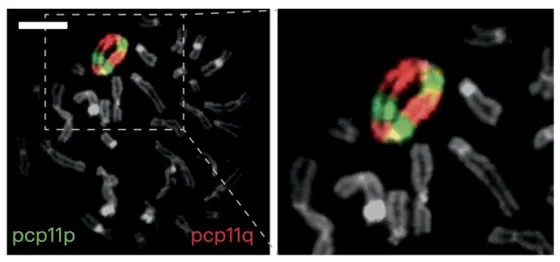In particular, under the selection pressure of cancer therapies, tumor cells undergo a veritable evolution to adapt to the changing conditions – and often escape the effects of therapy as a result. This evolution under therapeutic pressure is driven by a combination of genetic changes and non-genetic influences. Epigenetic modifications and changes in the transcriptome play a central role here, promoting the adaptation and activation of proliferation and survival programs.
This results in an extremely heterogeneous population of cancer cells with different properties in each patient – making it almost impossible for experts to identify which cellular changes affect the tumor's ability to survive or its aggressiveness.
This does not apply equally to all types of cancer. Particularly affected, for example, are patients with a special form of blood cancer, acute myeloid leukemia with complex karyotype (CK-AML). The chromosomes of these leukemia cells are in a state of enormous distortion: segments are lost, duplicated, or inserted the wrong direction. Experts call this chaotic condition chromosomal instability, or “chromothripsis.“ The prognosis for those affected is significantly worse than for AML patients with normal chromosome sets, since their disease often does not respond to any of the available therapies.
“Although all experts agree that chromosomal chaos is the cause of the poor therapeutic response of these leukemia cells, no one knows exactly which molecular changes contribute to disease progression and drug resistance,“ says Maija Leppä, first author of the paper. To create the knowledge base for developing better therapies, a team led by Andreas Trumpp, HI-STEM director and head of the Stem Cells and Cancer Division at the DKFZ, and Jan Korbel from EMBL has now analyzed the heterogeneity and evolution of CK-AML in unprecedented detail. Samples were obtained from eight patients before the start of treatment, and from two additional patients before and after therapy.
The molecular analyses at the single-cell level captured structural genomic and epigenetic variants in the same cell, as well as investigations of the transcriptome and cell surface proteins.
The researchers uncovered an enormous cellular and molecular heterogeneity of leukemia cells within each individual patient's disease. The genome was in some cases extremely remodeled, with up to 64 structural genomic aberrations in a single cancer cell. In six of the eight samples, multiple leukemia cell subclones were found. The evolution of the clones could also be traced using these analytical methods: In addition to a linear sequence, there were also highly branched patterns of development in which numerous subclones were detectable at the same time.
Using patient-derived xenografts (leukemia cells transplanted into immunocompromised mice), the researchers were able to follow the molecular evolution of these subclones and investigate the molecular changes behind the dominance of individual clones. One subclone, which only accounted for about five percent of the original AML, proved to be very dominant in the transplanted mice and was also responsible for the patient's disease relapse, while the other subclones were eliminated by chemotherapy.
In an ex vivo drug screen, therapeutic alternatives were identified for some subclones that were resistant to the standard therapy. For example, clones that were no longer responsive to the drug venetoclax (which blocks the survival factor Bcl-2) responded to the drug elesclomol, which triggers oxidative stress in the leukemia cells.
Longitudinal analyses of patient samples before and after the start of therapy identified certain genomic events as causes of disease relapse. For example, leukemia cells with more pronounced stem cell properties and more aggressive growth developed in connection with the activation of the Ras signaling pathway, against which new classes of drugs are currently being developed worldwide.
“Using state-of-the-art single-cell analyses, we are able to illustrate the cellular heterogeneity of CK-AML and show the evolutionary processes it undergoes. Our work provides a model for how leukemia stem cells, which drive disease progression and therapy resistance, can be identified early and targeted in the future. This technology can also be used to study other types of cancer with chromosomal chaos, such as carcinoma metastases, much more precisely,“ Trumpp summarizes.
Leppä, M. et al.: Single-cell multiomics analysis reveals dynamic clonal evolution and targetable phenotypes of acute myeloide leukemia with komplex karyotype.
Nature Genetics 2024, DOI: 10.1038/s41588-024-01999-x
*The Heidelberg Institute for Stem Cell Research and Experimental Medicine (HI-STEM) gGmbH was founded in 2008 as a public-private partnership between the DKFZ and the Dietmar Hopp Foundation.



